Abstract
The fact that one cell encodes a single antibody sequence does not necessarily mean that the resulting antibody folds into a single structure, although this is a common assumption. Here we challenge this view and suggest that many antibodies do not have a single conformation at the combining site. The basis for this proposal comes from the kinetic analysis of a set of murine hybridomas derived from defined stages of the immune response to 2-phenyl-5-oxazolone (Ox). Among them we have identified three antibodies that exhibit complex hapten-binding kinetics. We observed biphasic or triphasic reactions in stopped-flow fluorescence experiments, indicating that ligand binding involved isomerization, as well as associative steps. The existence of an equilibrium between at least two antibody conformations, with ligands binding preferentially to one form, was deduced from the variation with hapten concentration of the apparent rate of each phase.
Full text
PDF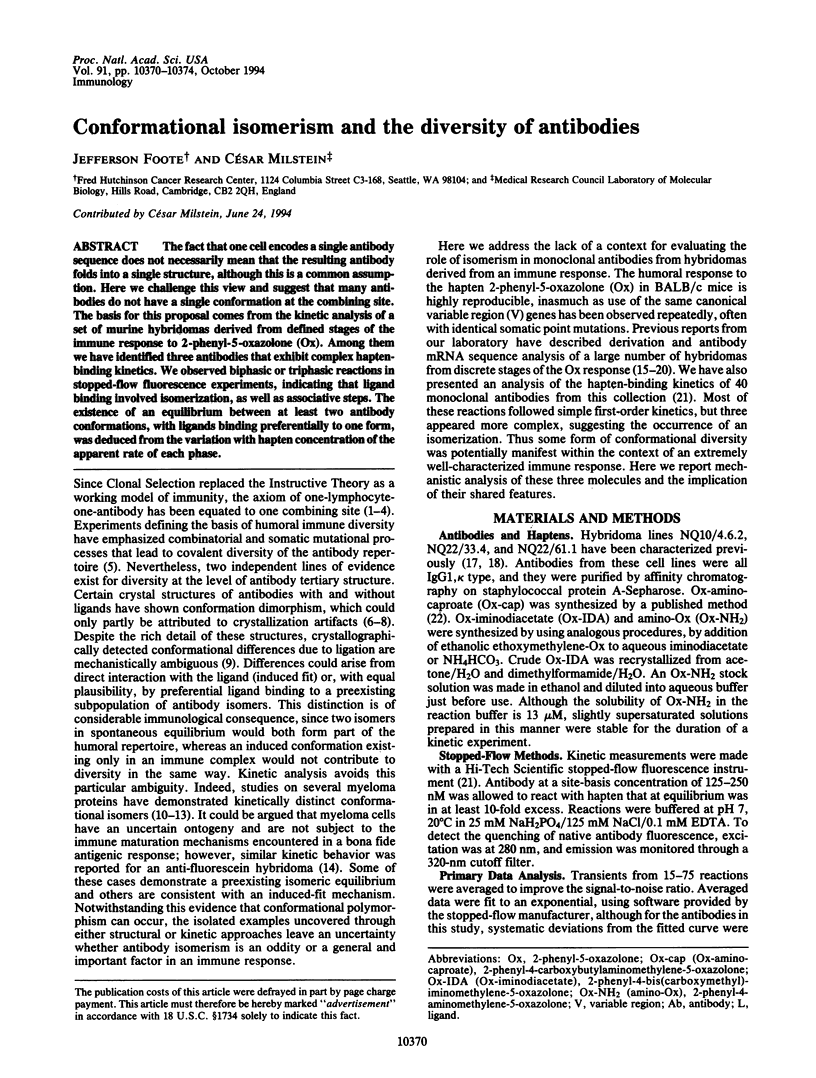
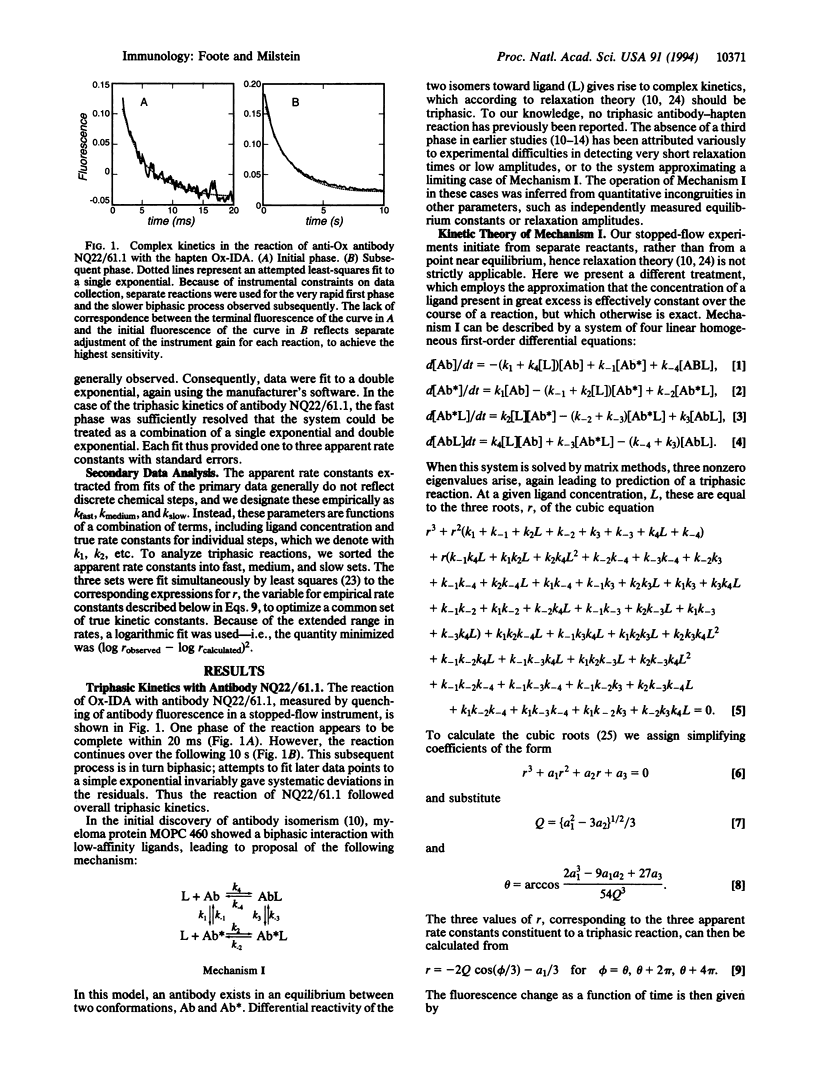
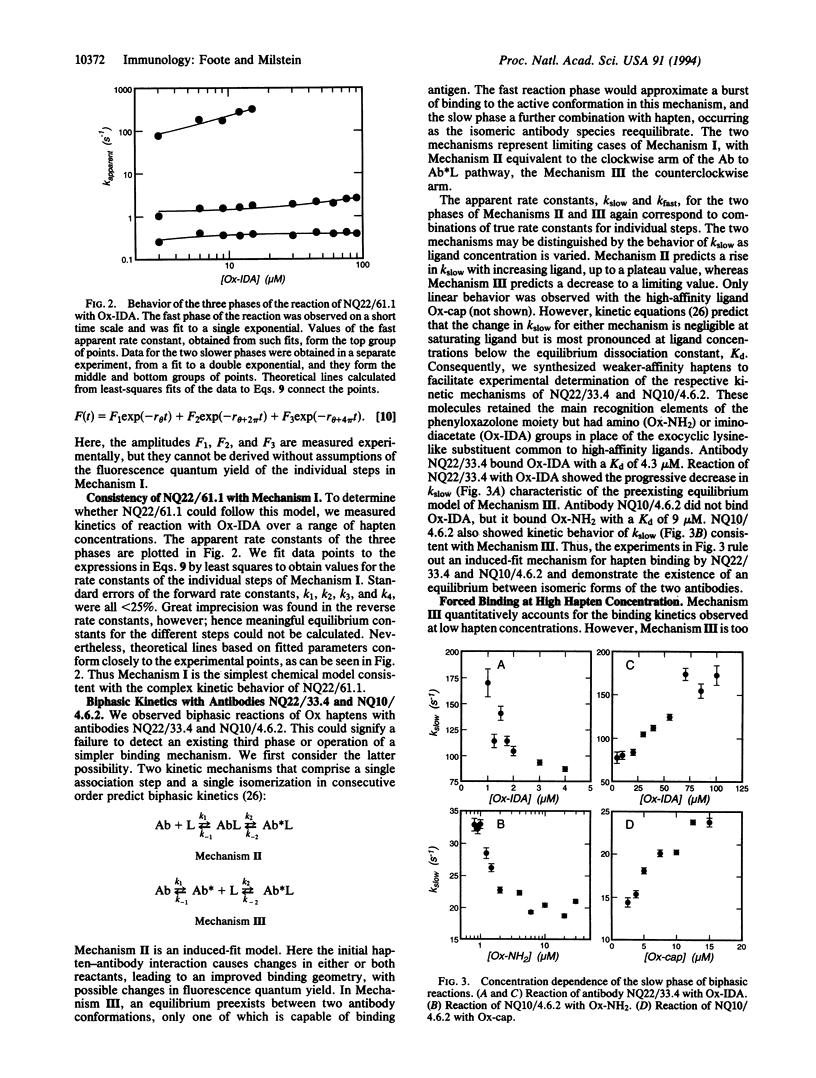
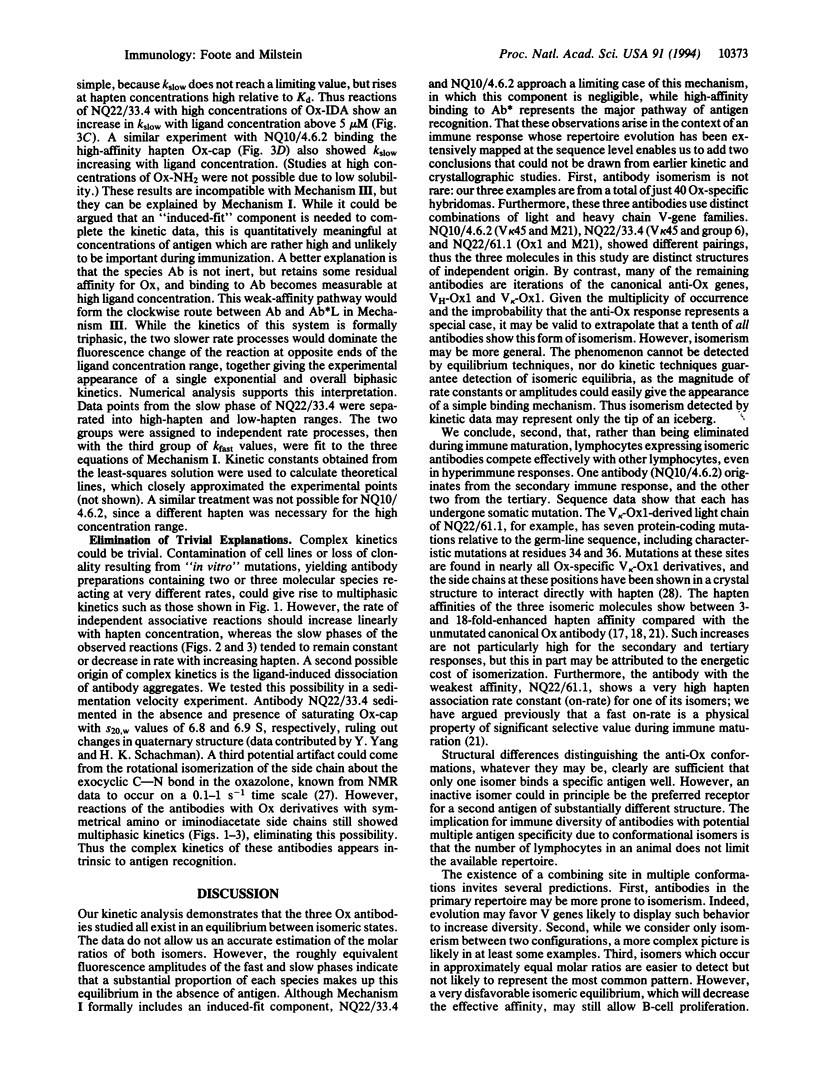
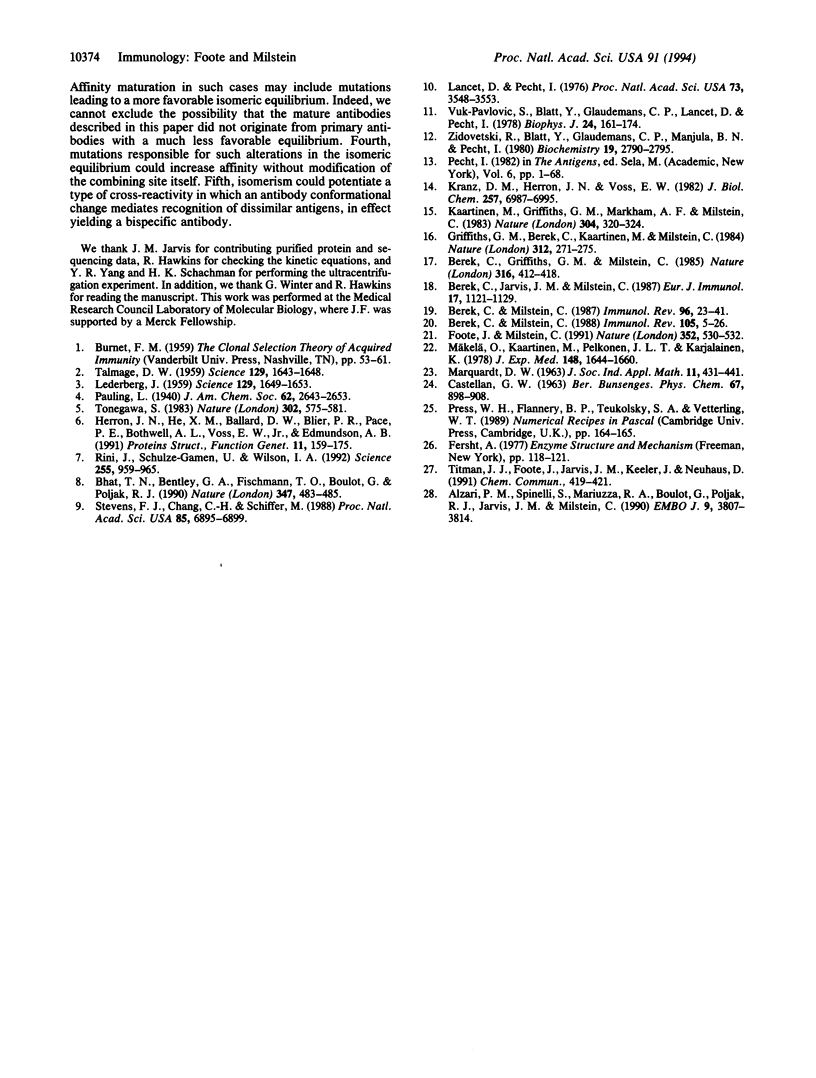
Selected References
These references are in PubMed. This may not be the complete list of references from this article.
- Alzari P. M., Spinelli S., Mariuzza R. A., Boulot G., Poljak R. J., Jarvis J. M., Milstein C. Three-dimensional structure determination of an anti-2-phenyloxazolone antibody: the role of somatic mutation and heavy/light chain pairing in the maturation of an immune response. EMBO J. 1990 Dec;9(12):3807–3814. doi: 10.1002/j.1460-2075.1990.tb07598.x. [DOI] [PMC free article] [PubMed] [Google Scholar]
- Berek C., Griffiths G. M., Milstein C. Molecular events during maturation of the immune response to oxazolone. Nature. 1985 Aug 1;316(6027):412–418. doi: 10.1038/316412a0. [DOI] [PubMed] [Google Scholar]
- Berek C., Jarvis J. M., Milstein C. Activation of memory and virgin B cell clones in hyperimmune animals. Eur J Immunol. 1987 Aug;17(8):1121–1129. doi: 10.1002/eji.1830170808. [DOI] [PubMed] [Google Scholar]
- Berek C., Milstein C. Mutation drift and repertoire shift in the maturation of the immune response. Immunol Rev. 1987 Apr;96:23–41. doi: 10.1111/j.1600-065x.1987.tb00507.x. [DOI] [PubMed] [Google Scholar]
- Berek C., Milstein C. The dynamic nature of the antibody repertoire. Immunol Rev. 1988 Oct;105:5–26. doi: 10.1111/j.1600-065x.1988.tb00763.x. [DOI] [PubMed] [Google Scholar]
- Bhat T. N., Bentley G. A., Fischmann T. O., Boulot G., Poljak R. J. Small rearrangements in structures of Fv and Fab fragments of antibody D1.3 on antigen binding. Nature. 1990 Oct 4;347(6292):483–485. doi: 10.1038/347483a0. [DOI] [PubMed] [Google Scholar]
- Foote J., Milstein C. Kinetic maturation of an immune response. Nature. 1991 Aug 8;352(6335):530–532. doi: 10.1038/352530a0. [DOI] [PubMed] [Google Scholar]
- Griffiths G. M., Berek C., Kaartinen M., Milstein C. Somatic mutation and the maturation of immune response to 2-phenyl oxazolone. Nature. 1984 Nov 15;312(5991):271–275. doi: 10.1038/312271a0. [DOI] [PubMed] [Google Scholar]
- Herron J. N., He X. M., Ballard D. W., Blier P. R., Pace P. E., Bothwell A. L., Voss E. W., Jr, Edmundson A. B. An autoantibody to single-stranded DNA: comparison of the three-dimensional structures of the unliganded Fab and a deoxynucleotide-Fab complex. Proteins. 1991;11(3):159–175. doi: 10.1002/prot.340110302. [DOI] [PubMed] [Google Scholar]
- Kaartinen M., Griffiths G. M., Markham A. F., Milstein C. mRNA sequences define an unusually restricted IgG response to 2-phenyloxazolone and its early diversification. 1983 Jul 28-Aug 3Nature. 304(5924):320–324. doi: 10.1038/304320a0. [DOI] [PubMed] [Google Scholar]
- Kranz D. M., Herron J. N., Voss E. W., Jr Mechanisms of ligand binding by monoclonal anti-fluorescyl antibodies. J Biol Chem. 1982 Jun 25;257(12):6987–6995. [PubMed] [Google Scholar]
- LEDERBERG J. Genes and antibodies. Science. 1959 Jun 19;129(3364):1649–1653. doi: 10.1126/science.129.3364.1649. [DOI] [PubMed] [Google Scholar]
- Lancet D., Pecht I. Kinetic evidence for hapten-induced conformational transition in immunoglobin MOPC 460. Proc Natl Acad Sci U S A. 1976 Oct;73(10):3549–3553. doi: 10.1073/pnas.73.10.3549. [DOI] [PMC free article] [PubMed] [Google Scholar]
- Näkelä O., Kaartinen M., Pelkonen J. L., Karjalainen K. Inheritance of antibody specificity V. Anti-2-phenyloxazolone in the mouse. J Exp Med. 1978 Dec 1;148(6):1644–1660. doi: 10.1084/jem.148.6.1644. [DOI] [PMC free article] [PubMed] [Google Scholar]
- Rini J. M., Schulze-Gahmen U., Wilson I. A. Structural evidence for induced fit as a mechanism for antibody-antigen recognition. Science. 1992 Feb 21;255(5047):959–965. doi: 10.1126/science.1546293. [DOI] [PubMed] [Google Scholar]
- Stevens F. J., Chang C. H., Schiffer M. Dual conformations of an immunoglobulin light-chain dimer: heterogeneity of antigen specificity and idiotope profile may result from multiple variable-domain interaction mechanisms. Proc Natl Acad Sci U S A. 1988 Sep;85(18):6895–6899. doi: 10.1073/pnas.85.18.6895. [DOI] [PMC free article] [PubMed] [Google Scholar]
- TALMAGE D. W. Immunological specificity, unique combinations of selected natural globulins provide an alternative to the classical concept. Science. 1959 Jun 19;129(3364):1643–1648. doi: 10.1126/science.129.3364.1643. [DOI] [PubMed] [Google Scholar]
- Tonegawa S. Somatic generation of antibody diversity. Nature. 1983 Apr 14;302(5909):575–581. doi: 10.1038/302575a0. [DOI] [PubMed] [Google Scholar]
- Vuk-Pavlović S., Blatt Y., Glaudemans C. P., Lancet D., Pecht I. Hapten-linked conformational equilibria in immunolglobulins XRPC-24 and J-539 observed by chemical relaxation. Biophys J. 1978 Oct;24(1):161–174. doi: 10.1016/S0006-3495(78)85353-3. [DOI] [PMC free article] [PubMed] [Google Scholar]
- Zidovetzki R., Blatt Y., Glaudemans C. P., Manjula B. N., Pecht I. A common mechanism of hapten binding to immunoglobulins and their heterologous chain recombinants. Biochemistry. 1980 Jun 10;19(12):2790–2795. doi: 10.1021/bi00553a039. [DOI] [PubMed] [Google Scholar]


